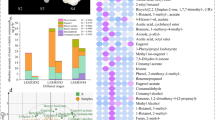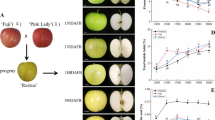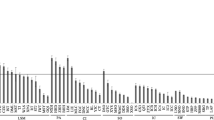Abstract
Rosa rugosa ‘Shanxian’, a local variety of rose in Shandong Province, was studied for its aroma characteristics, including changes in aroma components and differential expression of aroma-related genes during flowering. The volatiles emitted from flowers were collected by headspace solid-phase microextraction and analyzed by gas chromatography–mass spectrometry at the budding stage, the early, half and full opening stages, and the withering stage. Sixty-six compounds were identified, and the full opening stage contained the highest level of every single aroma component compared with the other four stages. The major constituents of R. rugosa ‘Shanxian’ were alcohols, esters, ketones, aldehydes, phenols, and terpenes, with alcohols being the most abundant. The aroma of R. rugosa ‘Shanxian’ was mainly characterized by rich fruit aromas, floral aromas, and soft plant aromas. RrAAT, RrDXR, and RrDXS genes played a key role in monoterpene biosynthesis in R. rugosa ‘Shanxian’. The temporal and spatial expression of RrAAT, RrDXR, and RrDXS were measured at different flower developmental stages. Among the three genes, the overall expression level of RrAAT was significantly higher than that of RrDXR and RrDXS and was associated with the accumulation of acetate esters in R. rugosa, which could be used as an important candidate gene for rose metabolism. Taken together, our results demonstrated that R. rugosa ‘Shanxian’ has better aromatic characteristics than R. rugosa ‘Fenghua’. With a particularly prominent aroma that is strong and sweet, ‘Shanxian’ should be further investigated as a valuable breeding material that could be used to enhance genetic diversity and develop new rose varieties.




Similar content being viewed by others
References
Chan WS, Abdullah JO, Namasivayam P, Mahmood M (2009) Molecular characterization of a new 1-deoxy-d-xylulose 5-phosphate reductoisomerase (DXR) transcript from Vanda Mimi Palmer. Sci Hortic 121:378–382. https://doi.org/10.1016/j.scienta.2009.02.015
Chen T, Li JJ, Chen JL, Song HP, Yang CH (2015) Anti-hyperplasia effects of Rosa rugosa polyphenols in rats with hyperplasia of mammary gland. Environ Toxicol Phar 39:990–996. https://doi.org/10.1016/j.etap.2015.02.014
Compilation Committee of Shanxian County local chronicles of Shandong province (1996) Shanxian County Records. Shandong People’s Publishing House, Jin’an, China, pp 25–83
Cordoba E, Salmi M, León P (2009) Unravelling the regulatory mechanisms that modulate the MEP pathway in higher plants. J Exp Bot 60:2933–2943. https://doi.org/10.1093/jxb/erp190
Cordoba E, Porta H, Arroyo A, Román CS, Medina L, Rodríguez-Concepción M, León P (2011) Functional characterization of the three genes encoding 1-deoxy-d-xylulose 5-phosphate synthase in maize. J Exp Bot 62:2023–2038. https://doi.org/10.1093/jxb/erp393
Dudareva N, Cseke L, Blanc VM, Pichersky E (1996) Evolution of floral scent in Clarkia: novel patterns of S-linalool synthase gene expression in the C. breweri flower. Plant Cell 8:1137–1148. https://doi.org/10.1105/tpc.8.7.1137
Feng LG, Sheng LX, Zhao LY, Yu XY, Shao DW, He XD (2008) Changes of the aroma constituents and contents in the course of Rosa rugosa Thunb. flower development. Sci Agric Sin 41:4341–4351
Feng LG, Chen C, Sheng LX, Liu P, Tao J, Su JL, Zhao LY (2010) Comparative analysis of headspace volatiles of Chinese Rosa rugosa. Molecules 15:8390–8399. https://doi.org/10.3390/molecules15118390
Feng LG, Chen C, Li TL, Wang M, Tao J, Zhao DQ, Sheng LX (2014) Flowery odor formation revealed by differential expression of monoterpene biosynthetic genes and monoterpene accumulation in rose (Rosa rugosa Thunb.). Plant Physiol Biochem 75:80–88. https://doi.org/10.1016/j.plaphy.2013.12.006
Feng LG, Meng W, Jia W, Shu Z, Wei X, Sheng LX (2015) Isolation of 2-phenylethanol biosynthesis related genes and their relationship with 2-phenylethanol accumulation in Rosa rugosa. Acta Physiol Plant 37:256. https://doi.org/10.1007/s11738-015-1996-3
Forney CF, Kalt W, Jordan MA (2000) The composition of strawberry aroma is influenced by cultivar, maturity and storage. HortScience 35:1022–1026. https://doi.org/10.1023/A:1026555603552
Hou XJ, Han JC, Yuan CS, Ren HH, Zhang Y, Zhang T, Xu LX, Zheng QS, Chen W (2016) Cardioprotective effects of total flavonoids extracted from Xinjiang Sprig Rosa rugosa against acute ischemia/reperfusion-induced myocardial injury in isolated rat heart. Cardiovasc Toxicol 16:54–66. https://doi.org/10.1007/s12012-015-9308-0
Kolosova N, Gorenstein N, Kish CM, Dudareva N (2001) Regulation of circadian methyl benzoate emission in diurnally and nocturnally emitting plants. Plant Cell 13:2333–2347. https://doi.org/10.1105/tpc.010162
Kurkcuoglu M, Baser KHC (2003) Studies on Turkish rose concrete, absolute, and hydrosol. Chem Nat Compd 39:457–464. https://doi.org/10.1023/B:CONC.0000011120.71479.7f
Li M, Tian YY, Geng J (2009) Analysis on peroxidase zymograms of shandong Rugosa Rose. Lishizhen Med Mater Med Res 20:1624–1625
Lin XY (2008) Perfumery. Chemical Industry Publishing House, Beijing, pp 52–65
Liu JZ, Liu JH, Dong FY, Cheng CG (1991) Analysis of Shanxian County rose oil. Shandong Sci 1:1–4
Maciag A, Kalemba D (2015) Composition of rugosa rose (Rosa rugosa thunb.) hydrolate according to the time of distillation. Phytochem Lett 11:373–377. https://doi.org/10.1016/j.phytol.2014.10.024
Magnard JL, RocciaA Caissard JC, Vergne P, Sun P, Hecquet R, Dubois A, Oyant LH-S, Jullien F et al (2015) Biosynthesis of monoterpene scent compounds in roses. Science 349:81–83. https://doi.org/10.1126/science.aab0696
Ohloef G, Demole E (1987) Importance of the odoriferous principle of Bulgarian rose oil in flavour and fragrance chemistry. J Chromatogr 406:181–183. https://doi.org/10.1016/S0021-9673(00)94029-9
Pichersky E, Lewinsohn E, Croteau R (1995) Purification and characterization of S-linalool synthase, an enzyme involved in the production of floral scent in Clarkia breweri. Arch Biochem Biophys 316:803–807. https://doi.org/10.1006/abbi.1995.1107
Rodríguez-Concepción M, Ahumada I, Diez-Juez E, Sauret-Güeto S, Lois LM, Gallego F, Carretero-Paulet L, Campos N, Boronat A (2001) 1-Deoxy-d-xylulose 5-phosphate reductoisomerase and plastid isoprenoid biosynthesis during tomato fruit ripening. Plant J 27:213. https://doi.org/10.1046/j.1365-313x.2001.01089.x
Shalit M, Guterman I, Volpin H, Bar E, Tamari T, Menda N, Adam Z, Zamir D, Vainstein A et al (2003) Volatile ester formation in roses: identification of an acetyl-coenzyme A. Geraniol/citronellol acetyltransferase in developing rose petals. Plant Physiol 131:1868–1876. https://doi.org/10.1104/pp.102.018572
Singh U, Dwivedi P, Sangwan RS, Mishra BB (2017) In situ rose oxide enrichment led valorization of citronella (Cymbopogon winterianus) essential oil. Ind Crops Prod 97:567–573. https://doi.org/10.1016/j.indcrop.2017.01.002
Sparinska A, Rostoks N (2012) Comparing ornamental and other quality traits of Rugosa hybrids in Latvia. Acta Hortic 953:277–283. https://doi.org/10.17660/ActaHortic.2012.953.38
Sparinska A, Rostoks N (2015) Volatile organic compounds of hybrid rugosa roses in Latvia. Proc Latv Acad Sci 39:57–61. https://doi.org/10.1515/prolas-2015-0007
Spurrier S (1984) The Academic Du Vin Concise Guide to French Country Wines. Willow Books, Perigee
Svejda F (1977) Breeding for improvement of flowering attributes of winterhardy Rosa rugosa hybrids. Euphytica 26:697–701. https://doi.org/10.1007/bf00021694
Tholl D, Gershenzon J (2015) The flowering of a new scent pathway in rose. Science 349:28–29. https://doi.org/10.1126/science.aac6509
Verma RS, Padalia RC, Chauhan A, Singh A, Yadav AK (2011) Volatile constituents of essential oil and rose water of damask rose (Rosa damascena Mill.) cultivars from North Indian hills. Nat Prod Res 25:1577–1584. https://doi.org/10.1080/14786419.2010.520162
Wang XR (2008) Molecular cloning of DXR and DXS gene and study on metabolic pathway of terpene aroma in Hedychiumcoronarium. Master Dissertation, Guangdong. Agricultural University South China, pp 59–60
Wilches I, Tobar V, Peñaherrera E, Cuzco N, Jerves L, Vander-HeydenY León-TamarizF, Vila E (2015) Evaluation of anti-inflammatory activity of the methanolic extract from Jungia rugosa leaves in rodents. J Ethnopharmacol 173:166–171. https://doi.org/10.1016/j.jep.2015.07.004
Wu DM, Shao DW, Feng LG, Zhao LY (2013) Study on antioxidant capacity of dried flower buds of different rose cultivars. North Hortic 17:67–70
Xu Y (2003) International Standard for Rose Oil (ISO9842:2003). Flavour Fragr Cosmet 6:36–37
Yang LN, Ren JW, Wang Y (2014) Chemical investigation of volatiles emitted from flowers of three varieties of damask rose cultivated in Beijing. Hortic Environ Biotechnol 55:524–530. https://doi.org/10.1007/s13580-014-0176-5
Zhao CY, Xue J, Cai XD, Guo J, Li B, Wu S (2016) Assessment of the key aroma compounds in rose-based products. J Food Drug Anal 24:471–476. https://doi.org/10.1016/j.jfda.2016.02.013
Zheng ZX (2011) Research advances in 1-deoxy-d-xylulose-5-phosphate reductoisomerase, a key enzyme in plant isoprenoid biosynthesis. J Anhui Agric Sci 39:5695–5696
Acknowledgements
We are grateful to Chao Wang for GC–MS analyzing, and Xiaotong Bao for sampling assistance (Shandong Agricultural University). We also thank Dr. Fangfang Ma (Shandong Agricultural University) for critically reading of the manuscript. This research was supported by the Natural Science Foundation of Shandong Province (ZR2011CM048) and the Agricultural Breeding Project of Shandong Province (Shandong Agricultural [2012]213).
Author information
Authors and Affiliations
Contributions
Wenli Wang is fully responsible for the research and revision of the manuscript. Wenli Wang and Yaru sun designed experiments and analyzed experimental results. Yarusun carried out experiments and wrote the manuscript. Lanyong Zhao assisted in the analysis of aroma component data and evaluation and instructed the revision of the corresponding contents of the manuscript. Chengshu Zheng gave guidance and participated in the discussion on functional gene expression analysis. Fangfang Ma contributed much in the data analysis and revised version of our manuscript.
Corresponding author
Ethics declarations
Conflict of interest
The manuscript have not been published in other refereed publications. Submission of a manuscript to the journal implies no concurrent submission elsewhere. The authors have no conflicting interests, and all authors have approved the manuscript and agree with its submission to the journal Horticulture, Environment, and Biotechnology (HEB). The publication of this manuscript has been approved by all co-authors.
Human and animal rights
This article does not contain any studies with human participants or animals performed by any of the authors.
Additional information
Communicated by Tae-Ho Han, Ph.D.
Publisher's Note
Springer Nature remains neutral with regard to jurisdictional claims in published maps and institutional affiliations.
Electronic supplementary material
Below is the link to the electronic supplementary material.
Rights and permissions
About this article
Cite this article
Sun, Y., Wang, W., Zhao, L. et al. Changes in volatile organic compounds and differential expression of aroma-related genes during flowering of Rosa rugosa ‘Shanxian’. Hortic. Environ. Biotechnol. 60, 741–751 (2019). https://doi.org/10.1007/s13580-019-00166-0
Received:
Revised:
Accepted:
Published:
Issue Date:
DOI: https://doi.org/10.1007/s13580-019-00166-0




